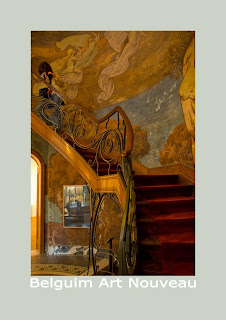Louis Tiffany
Probably the most famous person associated with the Art Nouveau style in the US is Louis Tiffany. He was born and studied art in New York before moving to Paris for further study.
He was to become famous for his Art Nouveau style glass art in particular his lamps. But he also created some outstanding paintings the ‘Snake Charmer of Tangiers’ created in 1915 considered one of his best.
On returning to New York he established a glass making factory. He invented a process for making opalescent glass known as ‘Tiffany favrile glass’. Louis created colourful windows, vases, lamps and other decorative art pieces. One of his most famous windows is the ‘Glass Curtain’ in the National Theater Mexico City.
He also designed jewelry, rugs, tiles and textiles. A window of landscaped glass panels for each season called the ‘Four Seasons’ (see below) was exhibited in Paris in 1892. This work established his international reputation.
His work included ornamental bowls, paperweights other objects. Colourful floral, abstracted floral or abstracted patterns and textures were used to create iridescent effects. His lamps had metal bases with one piece shades in stained glass.
Louis Sullivan
Sullivan was a Chicago architect who added ornament in a highly personalised style of natural organic forms to many of his buildings. The interior spaces of the ‘Chicago Auditorium Building’ were designed by Louis. The great arches studded with electric light bulbs with florid gilded ornamental relief in the Art Nouveau style are examples of his work.
Louis’ interest in creating tall buildings led him to a simple, modern style on the exteriors of his buildings in his later works. However in many of the interiors of the building he still used decorative ornament.
Frank Lloyd Wright
Frank first worked as a draftsman for Sullivan. Sullivan went on to be his mentor. They worked together on a number of projects of which Charnley House built in Chicago 1892 is an example. The windows below were created for the Chicago Auditorium window and are thought to have been designed by Frank Lloyd Wright who was a draughtsman on the project.
Sullivan is famous for building the first skyscraper and his still very much used statement ‘form follows function’. He was one of the main pioneers of modernism. Due to this Louis Sullivan’s work in the Art Nouveau style is often forgotten or overlooked.
Frank went on the clarify Sullivan's statement saying
‘Form follows function -
that has been misunderstood.
Form and function should be one,
joined in a spiritual union’
You may be interested in the video on YouTube of the Tiffany Exhibition at The Morse Museum of American Art just click on the link below

















































